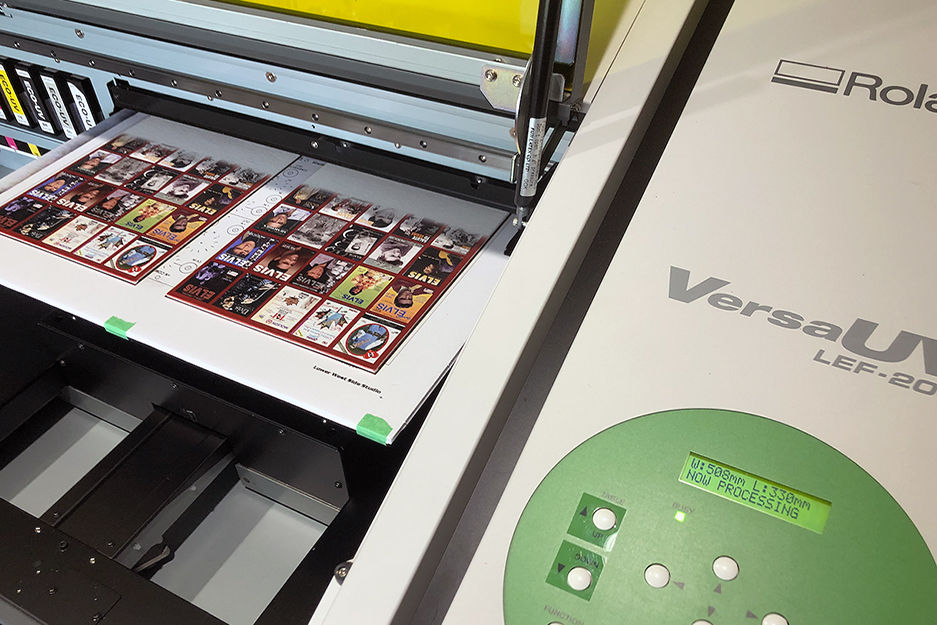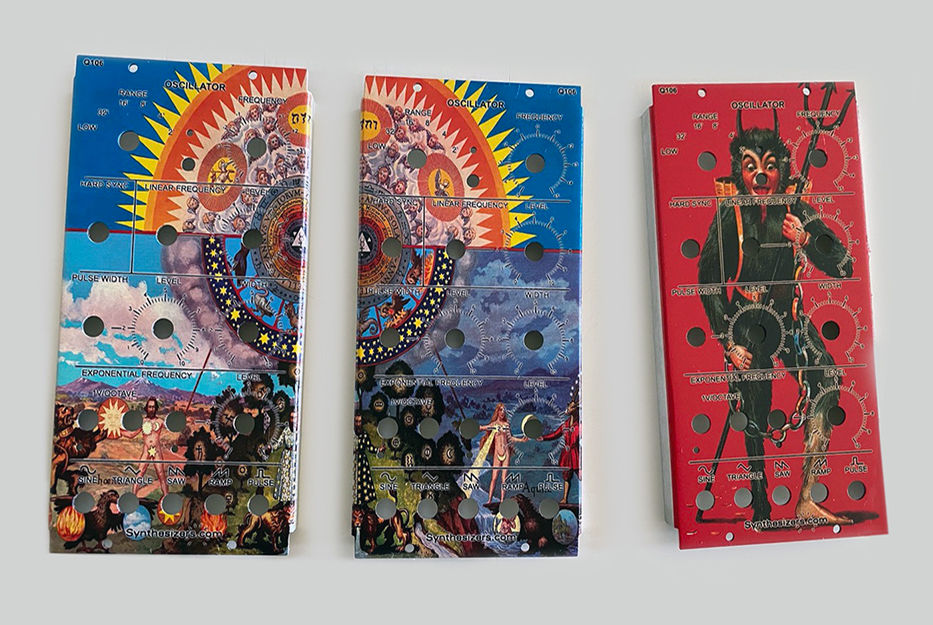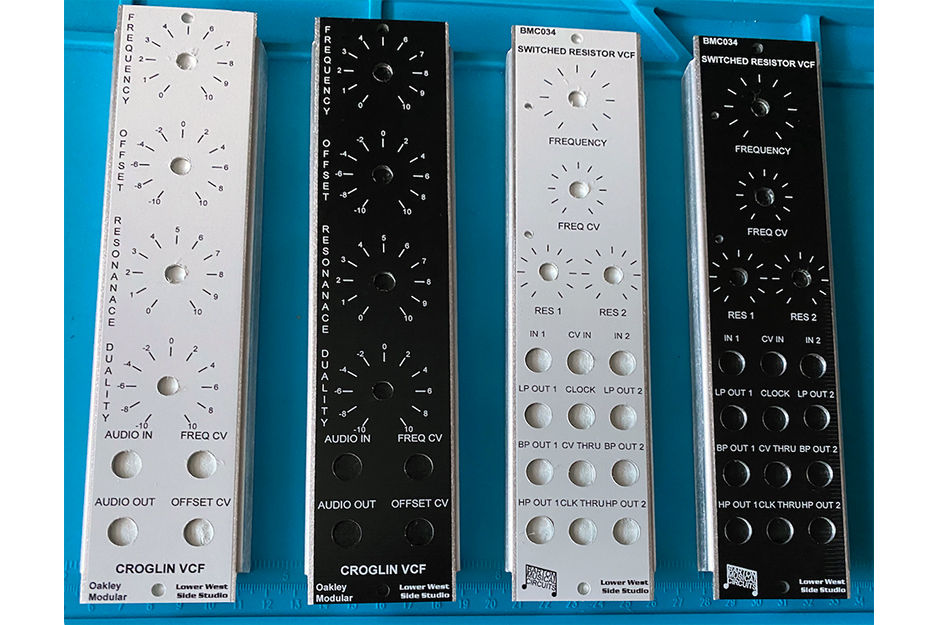Paneles Personalizados Que Hacen Bella la Música
Lower West Side Studio | Collingwood, Ontario, Canadá
Rich Sherkin casi se convirtió en músico profesional, pero las preocupaciones sobre su futuro financiero le hicieron enfocarse en la informática. Luego de una larga carrera en tecnología de la información (TI), él junto a su esposa se mudaron a Collingwood, Ontario, Canadá, y ahí empezó a crear música nuevamente. En el 2015 Rich armó su propio sintetizador de formato Moog Unit (MU) a partir de un kit. Entendiendo que existe un mercado para ensamblar estas unidades, las empezó a vender y llamó a su nueva empresa Lower West Side Studio.
Para hacer que su negocio se destaque, Sherkin ofrecía paneles personalizados de unidades de sintetizador. Al principio él imprimía los diseños mediante serigrafía, pero le frustraba dicho prolongado proceso. Investigar formas de aplicar gráficos sobre metal le condujo a la impresora UV de cama plana VersaUV® LEF-200 de Roland DG y a los distribuidores Roland DG Pam y Joe Daly en Daly Digital.
Hablamos con Rich sobre cómo empezó su negocio, cómo ofrecer paneles personalizados de sintetizadores ha contribuido al crecimiento de su negocio, y su imprevisto rol en el popular Festival anual de Elvis en Collingwood.
¿Cómo se dio cuenta que las unidades de sintetizador podían ser la base de su negocio?
En la década de los setentas había sido baterista y tocado teclados y sintetizadores cuando estaba de gira con bandas locales. En el 2010 mi esposa y yo nos mudamos a Collingwood, a más o menos 160 km al norte de Toronto, Canadá, y ahí empecé a tocar de nuevo.
“Con la LEF puedo pasar de concepto a prototipo en una hora... ¡A ver si eso se puede con la serigrafía!”
Pasé toda mi carrera en TI codificando sistemas de software para medicina y manufactura, y estoy muy familiarizado con la electrónica. En el 2015 decidí construir un sintetizador modular a partir de un kit. Comprendimos que había un mercado para ensamblar estas unidades, así que construí unidades adicionales y las vendí en eBay.Me estaba yendo bien y, entonces, en el 2016 me entró la idea de construir mi propio sintetizador modular: una gran pared de paneles electrónicos, con cables o patches entre una unidad y otra. Estas unidades ahora han vuelto a estar de moda.
Se corrió la voz y algunas personas me empezaron a preguntar si podía construir unidades para ellas. La parte más difícil del proceso de ensamblado de unidad es la construcción de los paneles frontales. Estos paneles son hechos de aluminio, y los paneles de sintetizador Moog Unit (MU) son doblados en una forma que los hace más difíciles de tratar que otros tipos de paneles de sintetizadores modulares.
¿Por qué decidió pasar a la impresión UV?
La mayoría de fabricantes usan la serigrafía para aplicar gráficos a los paneles. Busqué las tintas correctas, conseguí la malla correcta, y encontré la exposición correcta a la luz para hacer serigrafía por emulsión. Desafortunadamente la serigrafía toma demasiado tiempo y yo solamente podía hacer unas pocas al mismo tiempo sin comprar equipos caros. Era un proceso lento y frustrante. A menudo no lograba producir nada después de todo un día de trabajo. Además la tinta era fácil de correrse y frecuentemente terminaba manchando mi ropa.
A medida que la popularidad de mis productos aumentaba, mis factores limitantes eran la velocidad a la que podía producir estos paneles, y cuán intricados podía yo hacer estos gráficos. La mayoría de mis clientes querían paneles negros con tinta blanca, pero otros querían imágenes muy coloridas, incluso diseños eléctricos con neón.
Un día en el 2019 me llegó un pedido grande que involucraba muchísima serigrafía. Me dije a mí mismo que tenía que encontrar una mejor manera. Investigué cómo imprimir sobre metal y el primer resultado fue la impresora UV de cama plana de la serie LEF de Roland DG. Yo ya conocía a Roland DG desde hace mucho: mi familia está en el negocio de la manufactura y usamos cortadoras Roland DG. Vi un video en línea que mostraba la impresión LEF, y después coordiné una cita con Pam y Joe de Daly Digital. Les dije lo que necesitaba y programamos una fecha en la que yo les traiga algunos paneles y archivos de gráficos para hacer una impresión de prueba con la LEF. El resto es historia.
¿Cómo se involucró en el Festival de Elvis de Collingwood?
Cuando nos mudamos a Collingwood me uní a una banda y nuestro cantante, John Gabriele, opera un taller de impresión. Cada año él trabaja con la ciudad de Collingwood para su Festival de Elvis. Cuándo John supo que yo tenía esta nueva y asombrosa impresora UV, él me dijo: “¿Crees que puedes crear publicidad para el Festival de Elvis?”
Él trajo algunos flip-flops, cajas de joyería, llaveros, posavasos y cosas enmarcadas, junto con docenas de fotos completamente autorizadas del “Rey”. Por más de dos semanas mi sótano se había convertido en un templo a Elvis. Fue un periodo interesante. Fue también una gran forma de aprender sobre todas las habilidades de la LEF. ¡Los vibrantes gráficos que imprimimos hicieron que el “Rey” cobre vida!
Fue así como aprendimos el proceso de impresión de la LEF. Empecé a anunciar que si la gente quería gráficos sobre paneles debía comunicarse con nosotros. Con la LEF puedo imprimir casi cualquier diseño directamente sobre paneles de forma fácil y rápida.
¿Qué tipo de gráficos pide la gente?
Cuando recién empezamos a ofrecer gráficos, todos querían a Darth Vader o a la Estrella de la Muerte. Tuve que especificar que las obras protegidas por derechos de autor o de marcas registradas no estaban disponibles. También toda persona con quien hablaba quería que imprima sobre algo redondo, lo cual la LEF puede hacer; pero la habilidad de imprimir en paneles de metal es muy importante.
Los paneles son complejos debido a la variedad de perillas y controles que están por todas partes. Los clientes ordenan módulos en sitios Web como Synthesizer.com y me los mandan para que los personalice. Lijo los paneles e imprimo nuevos gráficos. Si un cliente no está contento con la forma en que el panel de un fabricante se ve, puedo cambiar el aspecto a su gusto.
Me piden inversiones de colores sólidos, negro sobre blanco, diseños especializados e imágenes personalizadas. Un panel en mi sintetizador personalizado tiene una bella foto de mi esposa: ¡Así ella me vigila mientras toco!
Tenemos un cliente en Alemania que construyó 120 módulos y se comunicó con nosotros porque necesitaba paneles personalizados. Él nos envió los paneles pre-impresos en su propio tono de negro y quería que yo imprima sobre los paneles el texto blanco y los gráficos que él había diseñado. Logré producir dichos módulos personalizados sin ninguna dificultad.
Parece que en su negocio hay mucho espacio para la innovación y el descubrimiento. ¿Cómo funciona el proceso de prototipado?
La impresora también nos hace ahorrar mucho tiempo en prototipado. Con la LEF puedo ir de concepto a prototipado en una hora; he medido ese tiempo en varias ocasiones. Simplemente esbozo un diseño, imprimo los objetivos de orificios, perforo los orificios y luego imprimo la imagen final de panel frontal. ¡Listo! ¡A ver si eso se puede con la serigrafía!
Tener la habilidad de prototipar rápidamente es también muy bueno para la innovación. Somos una comunidad de inventores, pero a la larga tenemos que convertir nuestras ideas en realidad. La habilidad de imprimir directamente en la LEF hace mucho más fácil el ciclo de iteraciones para un prototipo.
Una vez un cliente llamado Adam notó que un oscilador WTF, diseñado por su amiga Paula, tenía puertos en la parte trasera. Él se preguntó si podía conectarse a la unidad WTF con tipos específicos de paneles, y dibujó para mí sobre una servilleta lo que tenía en mente. A la mañana siguiente convertí ese dibujo en una imagen y en la tarde produje cuatro paneles. Al día siguiente los paneles impresos ya estaban en el correo. Estaba con muchísimos pedidos pero fui capaz de hacer un dibujo mientras tomaba mi café en la mañana e imprimir el prototipo con mis otros paneles en la tarde.
El proyecto de Adam con esta tecnología le mostró a Paula que ella tenía una oportunidad de módulo WTF, y ella rediseñó su módulo. Parece que Paula va a lanzar el diseño de Adam con nuestros paneles y puede que sea un nuevo producto para todos nosotros.
Sin embargo, por encima de todo, como persona informática, en verdad aprecio que una máquina como la LEF simplemente funcione. Me ha permitido hacer prototipos e imprimir rápidamente, lo cual ha afectado de una forma tremenda y positiva mi negocio, incrementando mis habilidades de producción y dándome una ventaja cualitativa por sobre la competencia.
¿Quiénes son algunos de sus clientes?
Mis clientes incluyen compositores sinfónicos, compositores de música para películas, productores musicales, DJs, músicos de clubes, e incluso un importante departamento de medios. Veo a algunos de ellos en la Internet y me asombro de sus logros. Es emocionante ver mis obras con artistas tan exitosos.
Lo interesante acerca de los componentes modulares es que uno puede tener módulos de diferentes compañías o productores en un solo sintetizador. Con la impresión precisa que logro con la LEF mis módulos se destacan: los negros son muy negros y los blancos son muy intensos. Otros productores no pueden alcanzar esa calidad o detalle. Puedo imprimir líneas de un punto o medio punto de forma muy precisa. Esta impresora es en verdad fabulosa.
¿Cómo está estructurada su empresa actualmente?
Es una empresa a cargo de una sola persona: yo. Tengo un socio encargado de paneles y otro encargado de diseños, y nuestras empresas trabajan juntas. Ya que la LEF es una máquina de sobremesa, puedo trabajar desde mi oficina. También compré el sistema de filtrado BOFA, así que no hay olores.
En este momento somos, de forma no oficial, el más grande productor canadiense de módulos de sintetizador de formato Moog Unit (MU). Vendemos más de 100 módulos por año, y por si fuera poco docenas de paneles personalizados. El grueso de nuestra clientela está disperso por Norteamérica y Europa, pero tenemos clientes en lugares tan alejados como Japón y Australia.
¿Cómo se ve el futuro para Lower West Side Studio?
Me estoy divirtiendo mucho con todo esto. Este mes estamos lanzando una línea totalmente nueva de módulos de sintetizadores. También seguimos expandiéndonos. Ahora tenemos paneles al por mayor pre-cortados con láser. Luego imprimimos los paneles y los vendemos a empresas que ofrecen bricolaje. Esperamos que alguno de los más grandes vendedores los tome.
Recientemente hablé con mi padre y llegamos a la conclusión de que la empresa no hubiera de ninguna manera crecido de forma tan rápida y efectiva sin la LEF-200. En sus propias palabras: “Comprar esa impresora fue la mejor decisión que hayamos tomado”.



